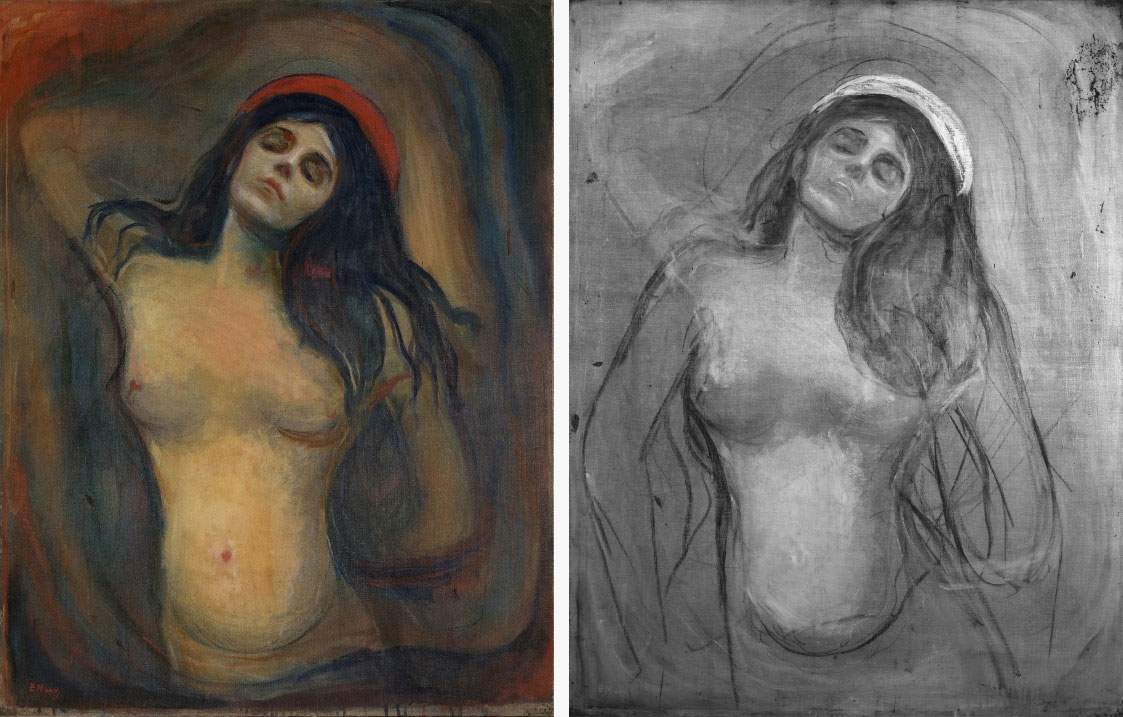Important discovery on Edvard Munch's Madonna: preparatory drawing resurfaces
Important discovery concerning Edvard Munch (Løten, 1863 - Oslo, 1944) at the Nasjonalmuseet in Oslo, Norway: underneath one of the great Scandinavian artist’s most famous paintings, the Madonna preserved in the Norwegian museum itself, some hitherto unknown preparatory drawings have been discovered. The discovery, described as “exciting” by the museum, bears the signature of conservator Thierry Ford and photographer Børre Høstland, who examined the work using the technique of infrared reflectography, which can reveal the layers that lie beneath the surface of paintings. The Madonna underwent preliminary analysis in preparation for conservation work to display it in the new Nasjonalmuseet, which will open on June 11, 2022.
The painting, among the best known of Munch’s production, depicts a woman arching her back, with one arm behind her head and the other behind her back. Preliminary drawings reveal that Munch tried a different composition before finally establishing the position of the arms he used for the final drafting. The discovery also has implications for the dating of the paintings: in fact, Edvard Munch painted five similarly sized versions of his Madonna, all between 1894 and 1897, but none of them are dated. Until now, the National Museum version was thought to be from 1894 or 1895. The discovery of Munch’s corrections to the painting thus supports the theory that the Nasjonalmuseet canvas is the first in the series.
“The new findings, together with previous research, make it possible to reasonably establish that Edvard Munch finished this first version of the Madonna in 1894,” says Vibeke Waallann Hansen, curator at the National Museum of Norway. “The discovery also provides interesting information about how the artist worked on the composition. Indeed, it is possible to see that the artist did a trial run with his arms stretched across his body. The preparatory drawings for the painting, along with other sketches for similar works, tell us that Munch was hesitant about how to position the arms of his Madonna.”
“We are excited about these latest discoveries that shed light on the Madonna and Edvard Munch’s creative process,” says Karin Hindsbo, director of the National Museum. “They indeed underscore the importance of collaborations across all fields of research, and in this case between our conservators and photographers. Our new museum has advanced technical facilities that will allow us to do much more research on the collection. We look forward to showing the Madonna and other of Munch’s most important paintings to the public again when we open the new Nasjonalmuseet next year.”
That of women is an important and recurring theme in Munch’s art, and his depictions of women are often ambiguous and full of contradictions. The title Madonna, commonly associated with the mother of Jesus, contrasts with both the figure and the alternative title, Elskend kvinde (Woman Making Love). The figure has a halo, but it is red rather than gold, as it would be in a religious image. “Edvard Munch’s depiction of ’a woman making love’ was something very new and sensational in Norway,” explains Vibeke Waallann Hansen. “There was no tradition about erotic motifs in Norwegian art in Munch’s time. When the painting was shown in Kristiania in 1895 it was hotly debated.”
“Infrared reflectography,” Thierry Ford points out, “is an imaging technique routinely used by restorers on paintings to ’see beneath the surface’ and can reveal the lower layers in a non-destructive way. Because paintings such as the Madonna and the Scream have been on permanent display for many years, moving to the new museum made it possible to conduct this type of research. The discovery was unexpected and exciting: it also confirms that there is more to be revealed in the museum’s collection of Munch works.”
 |
| Important discovery on Edvard Munch's Madonna: preparatory drawing resurfaces |
Warning: the translation into English of the original Italian article was created using automatic tools. We undertake to review all articles, but we do not guarantee the total absence of inaccuracies in the translation due to the program. You can find the original by clicking on the ITA button. If you find any mistake,please contact us.




























